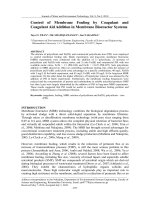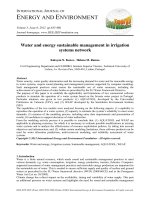Pediatric emergencies and first aid management
Bạn đang xem bản rút gọn của tài liệu. Xem và tải ngay bản đầy đủ của tài liệu tại đây (4.03 MB, 72 trang )
Pediatric Emergencies and
First Aid Management (1&2)
Objectives
At the end of the session participants should
recognize an emergency and should be able to
intervene and provide care.
2
Definition
First Aid is the immediate care that you give to
someone who is sick or injured before trained
help arrives and takes over.
American Heart
Association (AHA)
3
Aims of First Aid
•
•
•
•
•
Preserve life
Prevent further injury
Protect the unconscious
Promote recovery
Procure medical aid
4
Responsibilities of the First Aid
Provider
•
•
•
•
Ensure personal health and safety
Maintain a caring attitude
Maintain composure
Maintain up to date knowledge and skills.
5
Recommended First Aid Kit
Contents (1/4)
•
•
•
•
•
•
Bandages (including adhesive and elastic, of various
types and sizes)
Gauze pads (prefer non-stick) of various sizes
Tape of various widths, hypoallergenic
Antiseptic swab
Cold packs (instant or gel)
Cotton tipped applicators
Source: />
6
Continuation…
•
•
•
•
•
•
•
•
Cotton balls
CPR masks (paediatric and adult)/Face Shield
Disinfectant for surfaces and body fluid spills
Vinyl or latex gloves (powdered or powder free)
Disposable gowns
Eye irrigating bottle
Eye pads
Masks
Recommended First Aid Kit
Contents (2/4)
•
•
•
•
Plastic bags (large and small, resealable)
Safety pins
Scissors
Record forms (emergency cards, logs, medication,
sheets, accident reports, etc.)
• Slings and/or triangular bandages
Source: />8
Continuation…
•
•
•
•
•
•
•
Roller bandages
Burn dressing
Burn treatment
Assorted splints
Tissues
Tweezers
Goggles
Additional Equipment for
School Health Nurses
•
•
•
•
•
•
•
•
•
•
Tongue blades
Bandage shears
Stethoscope
Blood pressure cuff (adult and paediatric)
Penlight or flashlight
Biohazard waste bags and receptacles
Sharps container
Pen/pencil
Clip board
School approved emergency guidelines
10
Scene Safety
First ensure both you and the victim are
in a safe location.
• Assess for dangerous people
• Assess for dangerous environment
• Unstable surrounding
• Downed power lines
• Assess for danger in the accident
If the scene is dangerous, move the child
to a safer location
11
Universal Precautions
• Use Personal Protective Equipment
(PPE)
– Glove
– Masks
– Gown
– Goggles
• All disposable items touched body
fluids in a biohazard waste bag
• Hand Washing
12
CPR
CPR stands for cardiopulmonary resuscitation.
• It is an emergency lifesaving procedure that is
performed when a person's own breathing or
heartbeat have stopped, such as in cases of electric
shock, heart attack, or drowning.
• CPR combines chest compressions and rescue
breathing .
– Rescue breathing provides oxygen to the person's
lungs.
– Chest compressions keep oxygen-rich blood
circulating until an effective heartbeat and
breathing can be restored.
13
CPR and AED
•
•
•
•
Adult CPR
Child CPR
Using AEDs
Change from A-B-C to C-A -B
American Heart Association (AHA)
Adult CPR
•
•
•
•
CAB
Compression
Airway
Breathing
Demonstration of Adult CPR
Source: />15
Child CPR
•
•
•
•
CAB
Compression
Airway
Breathing
Demonstration of Child CPR
Source:: />
Checking for injuries and illnesses
Step
1
2
3
4
5
6
Action
Check the scene to make sure it is safe
Tap the child and shout, “Are you OK?”
Airway
Breathing (look, listen, feel)
Look for obvious signs of injury such as bleeding,
broken bones, burns or bites
Look for medical information jewelry
American Heart Association (AHA)
Automated External Defibrillator
(AED)
Automated External Defibrillators are an essential tool in
the diagnosis and treatment of cardiac episodes.
Indications
Unresponsive
No Pulse
Steps
Turn the AED on
Attach pads
Analysing the rhythm
Push the shock button if the AED tells you to do so.
Medical Emergencies
•
•
•
•
•
•
•
Asthma
Foreign Body Airway Obstruction-Choking
Anaphylaxis
Fainting
Diabetes and Low Blood Sugar
Seizures
Shock
19
Asthma
Asthma is an allergic reaction resulting in the
narrowing of the smaller airways especially
bronchioles.
20
Asthma: Recognition
Mild
• Dry, irritating, persistent cough, often at night or
morning and with exercise or activity
• Chest tightness
• Shortness of Breath
• Wheeze/ Gasping for breath
21
Continuation…
Severe
• Chest tightness
• Inability to speak more than one of two words per
breath
• Feeling distressed and anxious
• Little or no improvement after using “reliever”
medication.
• Blueness around lips and tongue
• Pale and sweaty
Asthma: Management
• If Responsive
– In a severe attack call an ambulance immediately
– Sit the person upright and reassure them.
– Give 4 separate puffs of a “reliever” medication.
– Wait 4 minutes, if no improvement repeat it
– Still no improvement call ambulance
• If Unresponsive
– Seek urgent medical assistance
– If needed start CPR
23
Anaphylaxis
• Anaphylaxis is the most severe form of allergic reaction.
It is potentially life-threatening and must be treated as a
medical emergency.
Source: />
24
Anaphylaxis: Recognition
•
•
•
•
•
•
•
•
•
•
Difficult / noisy breathing
Wheeze or persistent cough
Swelling of face and tongue
Swelling / tightness in throat
Difficulty talking and / or hoarse voice
Abdominal pain and vomiting
Hives, welts and body redness
Pale and floppy
Altered responsiveness
Collapse
25









